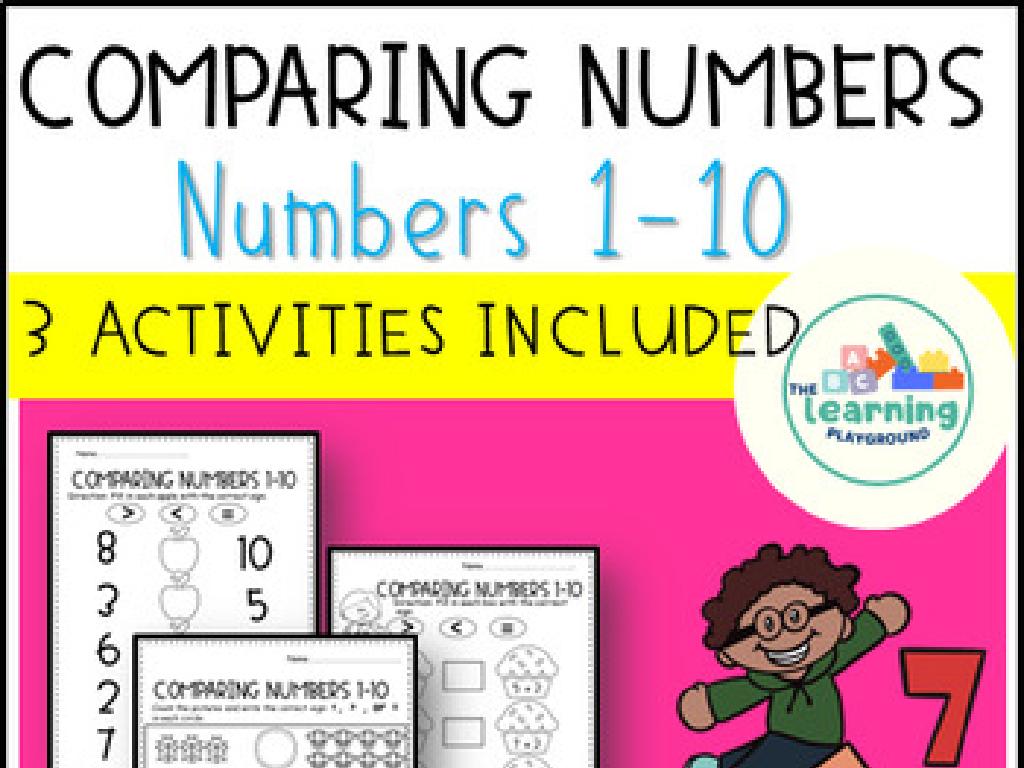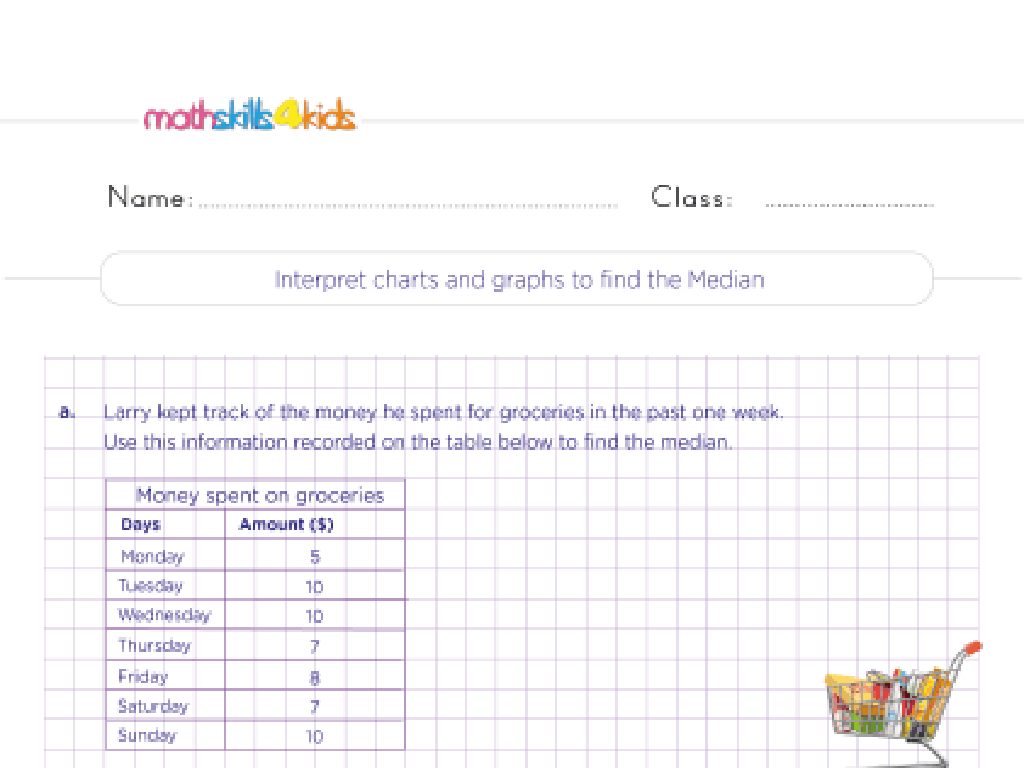Factor Numerical Expressions Using The Distributive Property
Subject: Math
Grade: Sixth grade
Topic: Equivalent Expressions
Please LOG IN to download the presentation. Access is available to registered users only.
View More Content
Understanding Equivalent Expressions
– Define equivalent expressions
– Expressions with the same value, even if they look different
– Equivalence in math terms
– If two expressions can be simplified to the same number, they’re equivalent
– Expressions and equivalence
– Different expressions can represent the same quantity
– Distributive property example
– Example: 3(2 + 4) is equivalent to 3*2 + 3*4
|
This slide introduces the concept of equivalent expressions in mathematics. Start by defining equivalent expressions as different expressions that represent the same value. Emphasize that equivalence is about the equality of the simplified value of expressions, not their appearance. Illustrate this with examples, showing that expressions can look different but represent the same quantity. Use the distributive property as a concrete example to show how to expand and factor expressions to find equivalences. Encourage students to think of their own examples and to practice using the distributive property to create equivalent expressions.
Review: The Distributive Property
– Recall Distributive Property
– a(b + c) = ab + ac, where ‘a’ is distributed over ‘b + c’
– Importance of this property
– It allows us to simplify expressions & solve equations efficiently
– Examples in use
– E.g., 3(x + 4) = 3x + 12 shows distribution over addition
– Practice problems
|
This slide is a review of the Distributive Property, which is a fundamental concept in algebra. Start by reminding students of the property’s formula, a(b + c) = ab + ac, and explain that ‘a’ is distributed to both ‘b’ and ‘c’. Emphasize the importance of this property in simplifying expressions and solving equations, making math problems more manageable. Provide clear examples, such as 3(x + 4) = 3x + 12, to illustrate the property in action. Conclude with practice problems to reinforce the concept, ensuring students understand how to apply the property to different numerical expressions.
Factoring Numerical Expressions
– Understanding expression factoring
– Factoring is breaking down expressions into simpler parts.
– Identifying the GCF
– GCF is the largest number that divides two or more numbers.
– Factoring with Distributive Property
– Use GCF to ‘distribute’ or break down expressions into parts.
– Practice factoring expressions
– Let’s factor 3x + 6 using the GCF, which is 3.
|
This slide introduces students to the concept of factoring numerical expressions using the distributive property. Begin by explaining that factoring is like reverse multiplication and is used to simplify expressions. Show how to find the Greatest Common Factor (GCF) of terms in an expression, which is the largest number that divides all the terms without a remainder. Then, demonstrate how to apply the distributive property to factor out the GCF from the expression, turning it into a product of simpler expressions. Provide practice problems for students to apply these concepts, such as factoring 3x + 6 by taking out the GCF, which is 3, to get 3(x + 2).
Factoring with the Distributive Property
– Understand the Distributive Property
– Example: Factor 3x + 6
– Distributive Property: a(b + c) = ab + ac. Now, let’s factor 3x + 6.
– Find the Greatest Common Factor (GCF)
– GCF of 3x and 6 is 3. It’s the largest number that divides both terms.
– Express as product of GCF and remaining terms
– Write 3x + 6 as 3(x + 2). Here, 3 is the GCF, and (x + 2) are the remaining terms.
|
This slide introduces students to the concept of factoring expressions using the distributive property. Start by explaining the distributive property as a way to multiply a single term by each term inside a parenthesis. Use the example 3x + 6 to show how to factor out the greatest common factor (GCF). In this case, the GCF is 3, which is the largest number that can evenly divide both 3x and 6. Once the GCF is determined, teach students to rewrite the expression as the product of the GCF and the remaining terms, resulting in 3(x + 2). Encourage students to practice with additional examples and ensure they understand each step of the process.
Practice: Factoring with Distributive Property
– Factor: 4x + 8
– Common factor: 4 (4 * (x + 2))
– Factor: 5y + 15
– Common factor: 5 (5 * (y + 3))
– Factor: 2n + 6m
– Common factor: 2 (2 * (n + 3m))
|
This slide presents practice problems for students to apply the distributive property to factor numerical expressions. Each example is a numerical expression that can be factored by finding the greatest common factor (GCF) and applying the distributive property. For instance, in the first example, 4 is the GCF of 4x and 8, so the expression can be factored as 4 * (x + 2). Encourage students to identify the GCF in each expression and rewrite the expression as a product of the GCF and the remaining terms. This exercise will help solidify their understanding of factoring and the distributive property. Provide guidance as needed and be ready to assist students who may struggle with identifying the GCF or applying the property correctly.
Class Activity: Factoring Expressions
– Work in pairs to factor expressions
– Share solutions with the class
– Discuss various factoring methods
– For example, how did 2(3x + 4) become 6x + 8?
– Reflect on different solutions
– Why might some pairs have different expressions?
|
This activity is designed to promote collaborative learning and critical thinking. Students will pair up and work on factoring numerical expressions using the distributive property. After they have worked through the problems, each pair will share their solutions with the class, fostering a discussion on the different methods used. Encourage students to explain their thought process and reasoning behind their factoring approach. As a teacher, prepare to guide the discussion by highlighting various techniques and addressing any misconceptions. Possible activities: 1) Factoring simple binomials, 2) Factoring and expanding expressions, 3) Peer review of factored expressions, 4) Creating their own expressions to factor, 5) Group discussion on the importance of factoring in solving equations.
Wrapping Up: Factoring with Distributive Property
– Recap on factoring expressions
– Homework: Factor 10 expressions
– Practice makes perfect! Try factoring expressions like 3(x+4) or 2(5+y).
– Use distributive property
– Remember, distribute or ‘break down’ numbers outside the parenthesis.
– Next class: Expanding expressions
|
As we conclude today’s lesson, ensure that students have grasped the concept of factoring expressions using the distributive property. For homework, they should apply this knowledge to factor 10 different expressions, reinforcing the day’s learning. Encourage them to look for a number that is common to all terms within an expression and use it to factor out of the parenthesis. Remind them that the next class will focus on expanding expressions, which is the reverse process of factoring. This will prepare them for a deeper understanding of equivalent expressions. Provide examples on the board for clarity and be available for any questions they may have about the homework.





